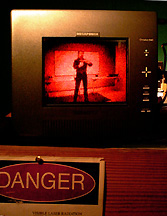
| |
|
DIGITAL HOLOGRAM PORTRAITS #2 -- 2/9/04
On Sunday night -- while waiting for the dedicated workstation -- I monitored a digital 8 video tape through the LCD panel via S-Video input, and rear-illuminated with laser light (27mw, 650nm laser diode). The laser light was sent just through an objective lens. No spatial filtering was used at this time. The above shot from my cheapo drugstore digital camera shows a sample of the output. The videocamera does a much better job at capturing laser-lit images, but since it was being used to supply the image to the LCD, it wasn't available to take a better shot. To go along with the LCD portrait experiments, I'm in the market at present for a high-end digital camera. However, I'm not sure ANY capture device will reproduce what the eye sees with laser light due to the overpowering saturation of whatever media is used (film, video, CCD, etc.). If a way does exist to take good laser-lit images, I haven't found it yet. The Proxima Ovation LCD panel contains many output adjustments, but this test was done "as is" out of the box. To the eye in the lab, the image was marginally acceptable in comparison to 35mm film projected onto ground glass. I will have to wait for the dedicated workstation (arriving this week), a high-end digital camera (shopping around), and careful tweaking of the LCD output parameters before making any noteworthy comparisons. No adjustments other than contrast were made tonight. At some point in the near future, I will hook up a DVD deck and run video calibration test patterns from my Avia DVD set. Which, I might add, are mostly greyscale calibration patterns -- even though you're calibrating a color signal. This will serve well since greyscale digital images will be used for the portraits. Despite the photo quaility (or lack thereof) above, the Ovation 846 is capable of high contrast -- completely blocking the transmssion of any laser light in the darkest areas. Whether this will also allow for shadow detail once tweaked remains to be seen.
The above being said, I do feel that it has great potential -- but I also feel that it will not be as "forgiving" as film-based work. A properly executed film-based frame projected and sharply focused onto ground glass is beautiful to behold with the eye. My initial reaction to the LCD display was "harsh", "hard", and for lack of a better term at the moment, "electronic" in its feel. Once again, this is "out of the box". When I first installed my wide-screen HD flat panel television out of the box, and turned it on, I almost vomited . . . so I do realize that its all up to careful and proper calibration. Also, this test tonight was a color video that was being rear-illuminated with monochromatic laser light . . . some color dyes may absorb more or less of the laser wavelength, introducing "bloom" in many areas, so not much can be set in stone until greyscale images are tested. So, in closing, I will say that it has potential and leave it at that. GO: First Workstation to LCD Test (2/18/04)
|
